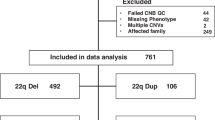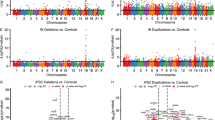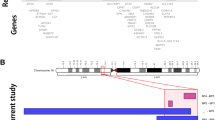Abstract
Chromosome 16 contains multiple copy number variations (CNVs) that predispose to genomic disorders. Here, we differentiate pathogenic duplications of 16p11.2–p12.2 from microscopically similar euchromatic variants of 16p11.2. Patient 1 was a girl of 18 with autism, moderate intellectual disability, behavioural difficulties, dysmorphic features and a 7.71-Mb (megabase pair) duplication (16:21 521 005–29 233 146). Patient 2 had a 7.81-Mb duplication (16:21 382 561–29 191 527), speech delay and obsessional behaviour as a boy and, as an adult, short stature, macrocephaly and mild dysmorphism. The duplications contain 65 coding genes of which Polo-like kinase 1 (PLK1) has the highest likelihood of being haploinsufficient and, by implication, a triplosensitive gene. An additional 1.11-Mb CNV of 10q11.21 in Patient 1 was a possible modifier containing the G-protein-regulated inducer of neurite growth 2 (GPRIN2) gene. In contrast, the euchromatic variants in Patients 3 and 4 were amplifications from a 945-kb region containing non-functional immunoglobulin heavy chain (IGHV), hect domain pseudogene (HERC2P4) and TP53-inducible target gene 3 (TP53TG3) loci in proximal 16p11.2 (16:31 953 353–32 898 635). Paralogous pyrosequencing gave a total copy number of 3–8 in controls and 8 to >10 in Patients 3 and 4. The 16p11.2–p12.2 duplication syndrome is a recurrent genomic disorder with a variable phenotype including developmental delay, dysmorphic features, mild to severe intellectual disability, autism, obsessive or stereotyped behaviour, short stature and anomalies of the hands and fingers. It is important to differentiate pathogenic 16p11.2–p12.2 duplications from harmless, microscopically similar euchromatic variants of proximal 16p11.2, especially at prenatal diagnosis.
Similar content being viewed by others
Log in or create a free account to read this content
Gain free access to this article, as well as selected content from this journal and more on nature.com
or
References
Itsara A, Cooper GM, Baker C et al. Population analysis of large copy number variants and hotspots of human genetic disease. Am J Hum Genet 2009; 84: 148–161.
Ghebranious N, Giampietro PF, Wesbrook FP et al. A novel microdeletion at 16p11.2 harbors candidate genes for aortic valve development, seizure disorder, and mild mental retardation. Am J Med Genet Part A 2007; 143A: 1462–1471.
Weiss LA, Shen Y, Korn JM et al. Association between microdeletion and microduplication at 16p11.2 and autism. N Engl J Med 2008; 358: 667–675.
Walters RG, Jacquemont S, Valsesia A et al. A new highly penetrant form of obesity due to deletions on chromosome 16p11.2. Nature 2010; 463: 671–675.
Cohen MM, Lerner C, Balkin NE : Duplication of 16p from insertion of 16p into 16q with subsequent duplication due to crossing over within the inserted segment. Am J Med Genet 1983; 14: 89–96.
Carrasco Juan JL, Cigudosa JC, Otero Gomez A et al. De novo trisomy 16p. Am J Med Genet 1997; 68 (219-221).
Engelen JJ, de Die-Smulders CE, Dirckx R et al. Duplication of chromosome region (16) (p11.2->p12.1) in a mother and daughter with mild mental retardation. Am J Med Genet 2002; 109: 149–153.
Finelli P, Natacci F, Bonati MT et al. FISH characterisation of an identical (16) (p11.2p12.2) tandem duplication in two unrelated patients with autistic behaviour. J Med Genet 2004; 41: e90.
Behjati F, Shafaghati Y, Firouzabadi SG et al. M-banding characterization of a 16p11.2p13.1 tandem duplication in a child with autism, neurodevelopmental delay and dysmorphism. Eur J Med Genet 2008; 51: 608–614.
Ballif BC, Hornor SA, Jenkins E et al. Discovery of a previously unrecognized microdeletion syndrome of 16p11.2-p12.2. Nat Genet 2007; 39: 1071–1073.
Tabet AC, Pilorge M, Delorme R et al. Autism multiplex family with 16p11.2p12.2 microduplication syndrome in monozygotic twins and distal 16p11.2 deletion in their brother. Eur J Hum Genet 2012; 20: 540–546.
Battaglia A, Novelli A, Bernardini L et al. Further characterization of the new microdeletion syndrome of 16p11.2-p12.2. Am J Med Genet Part A 2009; 149A: 1200–1204.
Hempel M, Rivera Brugués N, Wagenstaller J et al. Microdeletion syndrome 16p11.2-p12.2: clinical and molecular characterization. Am J Med Genet Part A 2009; 149A: 2106–2112.
Bijlsma EK, Gijsbers AC, Schuurs-Hoeijmakers JH et al. Extending the phenotype of recurrent rearrangements of 16p11.2: deletions in mentally retarded patients without autism and in normal individuals. Eur J Med Genet 2009; 52: 77–87.
Bachmann-Gagescu R, Mefford HC, Cowan C et al. Recurrent 200-kb deletions of 16p11.2 that include the SH2B1 gene are associated with developmental delay and obesity. Genet Med 2010; 12: 641–647.
Barge-Schaapveld DQCM, Maas SM, Polstra A et al. The atypical 16p11.2 deletion: A not so atypical microdeletion syndrome? Am J Med Genet Part A 2011; 155: 1066–1072.
Girirajan S, Rosenfeld JA, Cooper GM et al. A recurrent 16p12.1 microdeletion supports a two-hit model for severe developmental delay. Nat Genet 2010; 42: 203–209.
Barber JC : Directly transmitted unbalanced chromosome abnormalities and euchromatic variants. J Med Genet 2005; 42: 609–629.
Barber JC, Reed CJ, Dahoun SP et al. Amplification of a pseudogene cassette underlies euchromatic variation of 16p at the cytogenetic level. Hum Genet 1999; 104: 211–218.
Lopez Pajares I, Villa O, Salido M et al. Euchromatic variant 16p+ implications in prenatal diagnosis. Prenat Diagn 2006; 26: 535–538.
Ronaghi M, Uhlén M, Nyrén P : A sequencing method based on real-time pyrophosphate. Science 1998; 281: 363–365.
Barber JC, Maloney VK, Huang S et al. 8p23.1 duplication syndrome; a novel genomic condition with unexpected complexity revealed by array CGH. Eur J Hum Genet 2008; 16: 18–27.
Eichler EE, Lu F, Shen Y et al. Duplication of a gene rich cluster between 16p11.1 and Xq28: a novel pericentromeric directed mechanism for paralogous genome evolution. Hum Mol Genet 1996; 5: 899–913.
Whitby H, Tsalenko A, Aston E et al. Benign copy number changes in clinical cytogenetic diagnostics by array CGH. Cytogenet Genome Res 2008; 123: 94–101.
Bourthoumieu S, Esclaire F, Terro F et al. First prenatally diagnosed case of 16p11.2p12.1 duplication. Prenat Diagn 2008; 28: 254–256.
Huang N, Lee I, Marcotte EM et al. Characterising and predicting haploinsufficiency in the human genome. PLoS Genet 2010; 6: e1001154.
Wang H, Ouyang Y, Somers WG et al. Polo inhibits progenitor self-renewal and regulates Numb asymmetry by phosphorylating Pon. Nature 2007; 449: 96–100.
Girirajan S, Eichler EE : A recurrent 16p12.1 microdeletion suggests a two-hit model for severe developmental delay. Hum Mol Genet 2010; 19: R176–R187.
Artuso R, Papa FT, Grillo E et al. Investigation of modifier genes within copy number variations in Rett syndrome. J Hum Genet 2011; 56: 508–515.
Li F, Shen Y, Köhler U et al. Interstitial microduplication of Xp22.31: causative of intellectual disability or benign copy number variant? Eur J Med Genet 2010; 53: 93–99.
Furrow A, Theisen A, Velsher L et al. Duplication of the STS region in males is a benign copy-number variant. Am J Med Genet Part A 2011; 155A: 1972–1975.
Hastings PJ, Lupski JR, Rosenberg SM et al. Mechanisms of change in gene copy number. Nat Rev Genet 2009; 10: 551–564.
Guenthoer J, Diede SJ, Tanaka H et al. Assessment of palindromes as platforms for DNA amplification in breast cancer. Genome Res 2012; 22: 232–245.
Hall V, Maloney VK, White H et al. The use of pyrosequencing to identify copy number variation of 16p11.2 in euchromatic variant carriers and the normal population. J Med Genet 2006; 43 (Suppl 1): 3.26.
Fode P, Jespersgaard C, Hardwick RJ et al. Determination of beta-defensin genomic copy number in different populations: a comparison of three methods. PLoS One 2011; 6: e16768.
Acknowledgements
We thank all four families concerned as well as Dr Christine Garrett and Dr Kay MacDermot for their clinical input on Patient 1. We are grateful to Dr Petra Muschke (Magdeburg) for the information on Patient 3 and for contacting her for the second blood sampling. We thank Dr Ilona Dietze-Armana for sending information on Patient 4. We are also grateful to Professor Hunt Willard for the D16Z2 centromeric probe. VH, SH and HW were supported by the UK Department of Health as part of the National Genetics Reference Laboratory (Wessex).
WEB RESOURCES
DGV: http://projects.tcag.ca/variation/
DECIPHER v5.0: https://decipher.sanger.ac.uk/
Ensembl Genome Browser: http://www.ensembl.org/Homo_sapiens/Info/Index
UCSC Genome Browser: http://genome.ucsc.edu/
Author information
Authors and Affiliations
Corresponding author
Ethics declarations
Competing interests
The authors declare no conflict of interest.
Additional information
Supplementary Information accompanies the paper on European Journal of Human Genetics website
Supplementary information
Rights and permissions
About this article
Cite this article
Barber, J., Hall, V., Maloney, V. et al. 16p11.2–p12.2 duplication syndrome; a genomic condition differentiated from euchromatic variation of 16p11.2. Eur J Hum Genet 21, 182–189 (2013). https://doi.org/10.1038/ejhg.2012.144
Received:
Revised:
Accepted:
Published:
Issue date:
DOI: https://doi.org/10.1038/ejhg.2012.144
Keywords
This article is cited by
-
Genetic interaction between PLK1 and downstream MCPH proteins in the control of centrosome asymmetry and cell fate during neural progenitor division
Cell Death & Differentiation (2022)
-
Reversal of synaptic and behavioral deficits in a 16p11.2 duplication mouse model via restoration of the GABA synapse regulator Npas4
Molecular Psychiatry (2021)
-
Dose response of the 16p11.2 distal copy number variant on intracranial volume and basal ganglia
Molecular Psychiatry (2020)
-
The effect of copy number variations in chromosome 16p on body weight in patients with intellectual disability
Journal of Human Genetics (2019)
-
Genetic risk for schizophrenia and developmental delay is associated with shape and microstructure of midline white-matter structures
Translational Psychiatry (2019)



